Friday, June 18, 2010
Thursday, June 10, 2010
2011 New Opel Astra GSI Concept Cars Third Millennium




Friday, April 30, 2010
The 2010 Buick Regal - Opel Derived and Inspired

The news is just coming out that Buick's Regal will be making a return to the brand's line up. Produced by GM from 1973 to 2004, the Regal was at one time one of the best selling Buicks, offered in two and/or four door body formats. The most well known iteration of the Regal was the Grand National, a stock car that won several titles in the 1980s.
GM has been considering reviving the Regal name for some time. The company is turning to its European division, Opel, to produce the Regal, a model currently sold in China. Right now the Opel Insignia is sold across much of western Europe, thus GM is expected to offer a Buick version of that car by swapping out its grill and replacing Opel badging with Buick.
Article Source: http://EzineArticles.com/?expert=Matthew_Keegan
Wednesday, March 17, 2010
Opel Agila

5 doors and 5 seats, the new Opel Agila is not only as practical as its predecessor, which sold over 440,000 units, but is now also much more dynamically designed. The small, versatile Opel was unveiled to the public at the 2007 IAA in Frankfurt (September 13 - 23, 2007) and made its market premiere in spring 2008. It boasts balanced proportions, soft curves and a distinctive side graphic. Its passengers still sit high and upright, but the roofline has been dynamically lowered and now blends into a smooth arc toward the rear. This helps create the Opel Agila's aerodynamic drag coefficient of 0.35 - a relatively low figure for a vehicle of this size. The urban car is now 20 centimeters longer, six centimeters wider, but seven centimeters lower than its predecessor.
The front boasts typical Opel styling. With its round headlamps integrated into almond-shaped lamp units that echo the new Corsa, the Opel Agila sees the world through wide eyes. The tapering of the front and rear bumpers are also typical Opel elements, just like the crease in the hood. The rear also features several rounded details. The positioning of the narrow
The same is true for the interior: the boring days are over. A wide selection of fresh colors and modern styles create an ambience that's enhanced even more by the spacious headroom. The versatile five-seater's high seating position ensures good visibility, while the high placed gear stick and height-adjustable steering wheel with radio remote controls ensure easy operation. The rev counter is housed separately on the instrument panel. All other information readouts are given on large, distinctive, round instruments.
 As an urban car it also offers plenty of compartments and boxes for storing all passengers' belongings. But it's not just car essentials that the new Opel Agila stows away easily. Despite its compact exterior dimensions, the new Opel urban car boasts a surprisingly large
As an urban car it also offers plenty of compartments and boxes for storing all passengers' belongings. But it's not just car essentials that the new Opel Agila stows away easily. Despite its compact exterior dimensions, the new Opel urban car boasts a surprisingly largeAll Opel Agila models have a wide range of standard equipment, including safety features such as ABS, front and side airbags for driver and front passenger, front passenger airbag deactivation and mountings for the ISOFIX child seat system. And thanks to the five doors as standard, small children can be secured into a child seat quickly and safely. Standard comfort features in the entry-level version include speed-dependent power steering, height-adjustable driver and front passenger seats, washer with interval selection and power tailgate with touchpad. The Enjoy model boasts an even greater range of standard features.
2 gasoline engines make their world premiere in the new Opel Agila. Supplied by cooperation partner Suzuki, they share the same
 The entry-level unit is the almost one-liter, three-cylinder gasoline engine. The four-valve unit produces 65 hp (48 kW) and has a top speed of 160 km/h. The 1.2-liter four-cylinder gasoline engine produces 86 hp (63 kW), accelerates from zero to 100 km/h in less than 12 seconds and has a top speed of 174 km/h (values for five-speed manual version). This engine is now optionally available with a four-speed automatic transmission - an especially attractive alternative for city driving.
The entry-level unit is the almost one-liter, three-cylinder gasoline engine. The four-valve unit produces 65 hp (48 kW) and has a top speed of 160 km/h. The 1.2-liter four-cylinder gasoline engine produces 86 hp (63 kW), accelerates from zero to 100 km/h in less than 12 seconds and has a top speed of 174 km/h (values for five-speed manual version). This engine is now optionally available with a four-speed automatic transmission - an especially attractive alternative for city driving.The fuel-saving master among the Opel Agila engines is the 1.3-liter common-rail turbo-diesel. Developed by GM Powertrain, the diesel engine is a true multi-talent and also offers an especially efficient alternative in the Corsa and Astra model lines. In the new Opel Agila it produces 75 hp (55 kW), has a top speed of 162 km/h and a zero to 100 km/h
 Make the Opel Agila even more agile - that was the aim during chassis development. The new dynamic look is also reflected in the car's responsiveness. The Opel Agila's chassis, which features A-arms and McPherson struts in front and a torsion beam axle in the rear, is tuned for driving fun. Depending on the market and equipment variant, the Opel Agila also features an Electronic Stability Program (ESP).
Make the Opel Agila even more agile - that was the aim during chassis development. The new dynamic look is also reflected in the car's responsiveness. The Opel Agila's chassis, which features A-arms and McPherson struts in front and a torsion beam axle in the rear, is tuned for driving fun. Depending on the market and equipment variant, the Opel Agila also features an Electronic Stability Program (ESP).Friday, March 12, 2010
Opel GTC Concept

The GTC Concept embodies the confident, emotional direction we're taking with Opel. Its exciting lines combined with its high driving dynamics and interior flexibility reflect what the Opel brand trademark characteristics will be in the future.
The four-seat coupé is powered by a 220 kW/300 hp, 2.8-liter V6 turbo gasoline engine and features an intelligent, electronically-controlled four-wheel drive system, which provides optimum traction and stability as well as excellent agility in all driving conditions.
Brand-typical on-board flexibility is ensured by the thoughtful "Flex4" system (patent application submitted). The backs of both rear seats can be docked separately to the front seats by remote control, creating a spacious three or two-seater with flat load floor and up to 1020 liters of luggage compartment capacity. As is typical of Opel cars, the seats do not have to be removed or installed.

Dynamic design: Visually communicating the Opel brand promise
The GTC Concept reveals the next-generation of Opel styling. Much like the Opel Speedster did in 1999, or the GTC Genève Concept did in 2003 this car marks a break in the evolution of Opel's design language and signals that the next chapter is about to be written.
Key elements of the silk grey-lacquered Coupé concept car finished with a matte grey paint (length/width/height: 4830/1867/1432 millimeters, wheelbase: 2737 mm) begin with an aggressive front end performance face emphasized by large aluminum vertical intakes that intersect the headlamps. These vertical elements are mimicked in the rear exhaust elements, proposing an unmistakable down-the-road signature performance graphic, coming or going.
The proud front is highlighted by a prominent, trapezoidal grille with signature Opel bar and Blitz, executed in polished aluminum, and gracefully finished with a bolder Opel Blitz emblem concept. The centerline crease coupled with the distinctive aluminum vertical intakes and outboard LED vertical driving lamps choreograph in harmony to visually communicate power and strength. The distinctive design continues with LED technology, enabling creative headlamp inner shapes that propose a night time signature illumination graphic in the front and rear lamps.
Another significant design cue of the two-door sport-coupé with its sleek silhouette is the sophisticated bodyside shapes and surfacing. The sheetmetal surfaces suggest athleticism coupled with elegance to provide tasteful distinction in a visually loud marketplace. The car features sculpted side lines that further progress the Opel profile shown on the Antara and Opel GT production vehicles.
In addition, large flares hug the aggressive wheel and tire package, visually suggesting road confidence to the customer. Thanks to the wide track (front/rear: 1627/1629 mm), the Opel GTC Concept provides a commanding stance, planted by 20-inch rims with 245/40 R20 "red line" styled rubber. The wheels reference the motor sport aesthetic of black rims - however, elegantly finished with high- gloss black spokes contrasted with machine polished edges, alluding a signature performance wheel look.
The GTC Concept's rear visual solutions strategically echo the design language of the nose with an integrated rear bar and blitz emblem resting on the distinctive Opel rear center crease. Sophisticated surface development sculpturally integrates the rear spoiler into the sheetmetal to visually communicate performance. The rear appearance features Opel signature shaped rear lamps, uniquely displaying a LED night lighting graphic showcasing the exterior brand identity. The smart exterior shape and aerodynamic characteristics are rewarded by the cD value of 0.25.
 The Interior design: Warmer and more inviting
The Interior design: Warmer and more invitingOpel's interior designs have progressed to become warmer and more inviting in products like the new Corsa, Antara and Opel GT. However, the Opel GTC Concept significantly represents the next chapter of Opel's interior brand identity. Echoing the exterior, the interior shapes and surfaces are sculpturally-crafted to visually articulate a dynamic driving experience. The dashboard's top-pad wraps around from the instrument panel to the door, embracing the occupants. The sweeping décor dynamically stretches one's eye from the surfaces of the door and instrument panel, creating a memorable environment. The horizontal theme is secured with a large integrated centerstack design floating above the décor surface, an appearance reminiscent of premium audio equipment.
Complementing the exterior material theme, matte ebony surfaces are contrasted with rich high-gloss piano black décor finishes and structurally elegant aluminum accents, revealing a new standard of Opel aesthetics. The U-shaped aluminum graphic on the steering wheel is reflected again on the center console and the gear shifter, visually connecting the driving interfaces to emphasize Opel's driving dynamics. The rotating navigation control is ergonomically positioned, allowing it to easily be located and controlled by the driver, without having to remove his/her eyes from the road. The four, sporty, round instruments encircled by translucent rings are backlit in dynamic red, replacing Opel's traditional amber tones. These interior appearance solutions intentionally reinforce the dynamic ownership experience Opel provides.

As a final identity concept, the refined "redline" graphic of the tire pattern is vertically woven into the contoured sport seat surfaces and the centerline of the steering wheel, proposing that a visual performance identity can be distinctive without compromising taste.
Intelligent packaging: Compact exterior with spacious, flexible interior
With the lower seating position and vertical hip point ? known as the H-point? , both front occupants sit perfectly integrated in the car. Thanks to the lower-set instrument panel, outward visibility remains excellent. This also provides a generous sense of space, an effect strengthened by its color: the instrument panel's upper section is dark, while the lower section is light.
 The intelligent packaging is further highlighted by plenty of space in the rear of the Opel Concept car, despite its flat roof line: rear headroom is 920 millimeters. The rear seats are set low, but the four-seat, two-door car still offers Opel's brand-typical flexibility thanks to a novelty developed by Opel engineers: the "Flex4" interior concept (patent application submitted).
The intelligent packaging is further highlighted by plenty of space in the rear of the Opel Concept car, despite its flat roof line: rear headroom is 920 millimeters. The rear seats are set low, but the four-seat, two-door car still offers Opel's brand-typical flexibility thanks to a novelty developed by Opel engineers: the "Flex4" interior concept (patent application submitted)."Flex4" enables the backs of both the rear seats in the Coupé concept car to be moved forward separately at the touch of a button via sensor-control and docked to the front seats. The luggage compartment cover is thereby automatically pulled over the remaining seat surfaces in the floor. This creates a three or two-seater with a flat load floor up to 1.80 meters long. Luggage compartment capacity increases from 500 liters to 755 liters (three-seater) or up to 1020 liters (maximum capacity: up to waistline).
Powerful engine and intelligent four-wheel drive system
The Opel GTC concept car is powered by a turbocharged, 220 kW/300 hp, 2.8-liter V6 gasoline engine with two variable camshafts, which is combined with a six-speed manual transmission. Maximum torque of 400 Nm is available from 1850 up to 4500 rpm, and accelerating from zero to 100 km/h is calculated to take around six seconds. Top speed is limited to 250 km/h.
The power from the high-tech turbo engine is channeled via an advanced, electronically-controlled four-wheel drive system, which is fully integrated into the car's adaptive IDSPlus chassis management system. An electronically-regulated torque transfer device seamlessly distributes power between the front and rear axles for optimum traction and driving performance. The high-speed control allows more power to be provided to the rear axle before any traction loss can occur, for example during quick acceleration. This creates a driving feel similar to a sporty rear-wheel drive car. An electronically-controlled limited slip differential at the rear axle provides additional stability and traction thanks to torque distribution between the rear wheels.
Major benefits of the Opel GTC Concept's intelligent four-wheel drive system are: optimum traction and stability in all driving conditions as well as excellent agility and an active driving feel.
Thursday, March 4, 2010
2011 Opel Vauxhall Ampera Plug-in Hybrid
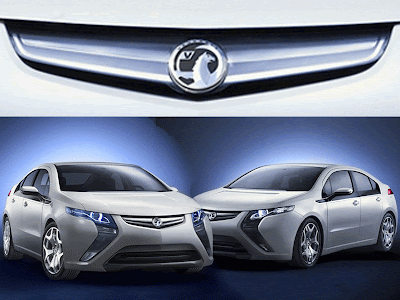



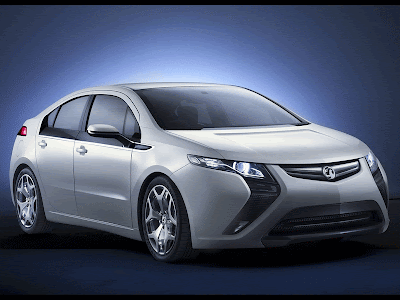
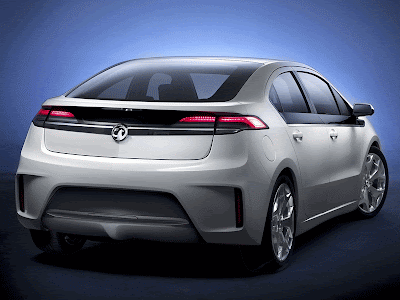
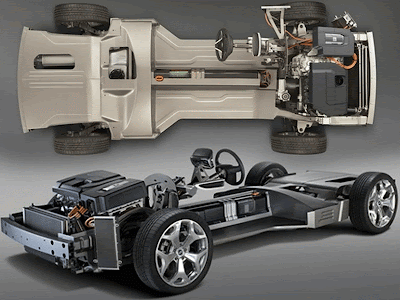

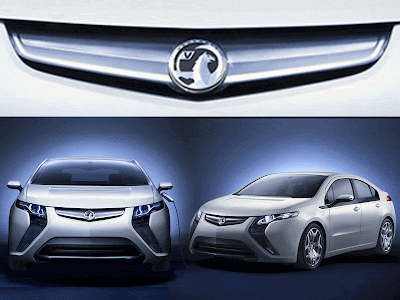

2011 Opel Vauxhall Ampera Plug-in Hybrid


















